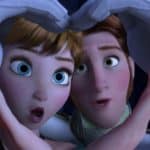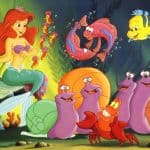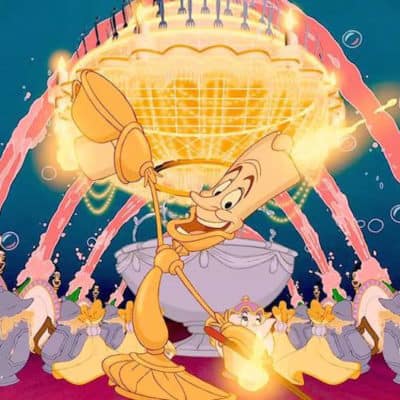About Beauty and the Beast
“Beauty and the Beast” (also known as “Tale as Old as Time”) is a song written by lyricist Howard Ashman and composer Alan Menken for Disney’s 1991 animated feature film of the same name. The title track of the 1991 Disney animated film Beauty and the Beast. The movie version, sung by Angela Lansbury as Mrs. Potts, during the scene where Belle and the Beast go on a big date in the castle, culminating in a dance in the castle’s ballroom.
Commonly identified as the film’s theme song, its lyrics describe how Belle and the Beast’s relationship has transformed them, allowing their friendship (and later, love) to grow with Lumiere, Cogsworth, and Chip. On the movie soundtrack, a pop version recorded by Celine Dion and Peabo Bryson plays during the closing credits and is credited as a “Duet.” The DVD version has a separate music video recording by the Christian pop group Jump5.
Beauty and the Beast Lyrics
[MRS. POTTS]
Tale as old as time
True as it can be
Barely even friends
Then somebody bends
Unexpectedly
Just a little change
Small to say the least
Both a little scared
Neither one prepared
Beauty and the Beast
Ever just the same
Ever a surprise
Ever as before
Ever just as sure
As the sun will rise
Tale as old as time
Tune as old as song
Bittersweet and strange
Finding you can change
Learning you were wrong
Certain as the sun
Rising in the east
Tale as old as time
Song as old as rhyme
Beauty and the Beast
Tale as old as time
Song as old as rhyme
Beauty and the Beast
Beauty and the Beast Video
Beauty and the Beast Lyrics Trivia
- Every single line of the song has five syllables.
- The song won an Academy Award for Best Original Song in 1992, marking Menken and Ashman’s (posthumously) second win after the 1989 award for “Under the Sea” from The Little Mermaid.
- It won the 1992 Golden Globe Award for Best Original Song. It later won two Grammy Awards in 1993, for Best Song Written for a Motion Picture, Television or Other Visual Media and Best Pop Performance by a Duo or Group with Vocal.
- The song is ranked #62 on the AFI’s 100 Years… 100 Songs list. It is one of only seven songs from Disney that made the cut.
- Angela Lansbury told the Huffington Post that Alan Menken and Howard Ashman had originally written the song in a rock ballad style. Although she liked it, she felt incapable of recording it because of the unfamiliar style in which it was written. She questioned the songwriters’ choice in her, asking them, “Are you sure you want me to do this?” She also felt that her voice wasn’t in suitable condition to record “Beauty and the Beast,” feeling insecure about having to sustain its several “long, extended notes.” Ashman and Menken simply advised her “to sing it the way [she] envisioned it.” Ultimately, she successfully recorded it in one take, which ended up in the film.
- Céline Dion and Peabo Bryson have included the song on some of their greatest hit and compilation albums.
- Both American pop group Jump5 and American Idol winner Jordin Sparks have recorded pop renditions of the song for the film’s platinum and diamond edition re-releases, respectively.
- Lansbury, Dion, and Bryson all performed the song live on stage during the 64th Academy Awards.
- Dion and Bryson also performed it at the Grammy Awards in 1993.
- The song was included later on Céline Dion’s greatest hits album All the Way… A Decade of Song (1999) and My Love: Essential Collection (2008).
- It won a Juno Award for the Single of the Year in Canada.

Beauty and the Beast Movie Trivia
- Dame Angela Lansbury (Mrs. Potts) thought that another character would be better suited to sing the ballad, “Beauty and the Beast.” Directors Gary Trousdale and Kirk Wise asked her to make at least one recording to have for a backup; that one recording ended up in the movie.
- The majority of the sculptures seen in the castle are different from earlier versions of the Beast.
- When Paige O’Hara was auditioning, a bit of her hair flew in her face, and she tucked it back. The animators liked this, so they put it in the movie.
- Songs take up twenty-five minutes of this movie and only five minutes were without any musical score at all.
- The last phrase of Cogsworth’s line “Flowers, chocolates, promises you don’t intend to keep…” was ad-libbed by David Ogden Stiers.
- This movie used 1,295 painted backgrounds and 120,000 drawings.
- Three hundred seventy men and women were involved in this movie’s production, of whom forty-three were animators.
- All songs were the last complete works for a movie by Academy Award winner Howard Ashman. Ashman died eight months prior to the release of this movie. This movie’s dedicated to Ashman; at the end of the final credits, you can read the dedication: “To our friend Howard, who gave a mermaid her voice and a beast his soul, we will be forever grateful.”
- Robby Benson’s voice was altered by the growls of real panthers and lions so that it is virtually unrecognizable. His voice is not changed on the original motion picture soundtrack, which is why his voice is different from the Prince (whose voice-over thoughts are heard in “Something There”).
- The first stained-glass window seen in the prologue has the Latin phrase “vincit qui se vincit”, which means, in a subtle prefiguring of the arc of the whole story, “He conquers, who conquers himself.”
- Chip is the only member of the Beast’s staff to refer to Belle by name.
- Many scenes were storyboarded but never animated. These include a scene where Gaston visits the asylum and a scene where the Beast is seen dragging the carcass of an animal he killed. Both were considered too gruesome for this movie, and the ideas were dropped. However, an animal’s skeleton can be seen, though just barely, since it is heavily in shadows in the corner of the West Wing, leaving a subtle implication of just how far his transformation had affected him.
- The smoke seen during the transformation at the end is actually real smoke, not animated.
- Glen Keane, the supervising animator on the Beast, created his own hybrid beast by combining the mane of a lion, the beard and head structure of a buffalo, the tusks and nose bridge of a wild boar, the heavily muscled brow of a gorilla, the legs and tail of a wolf, and the big and bulky body of a bear. He also has blue eyes, the one physical feature that does not change whether he is a beast or a human.
- The dance between Belle and Prince Adam in the finale is actually a re-used animation of the dance between Princess Aurora and Prince Phillip in Sleeping Beauty (1959). Because the animators were running out of time during the production of this movie, the original Sleeping Beauty (1959) pair had been drawn over to become the new Beauty and the Beast pair.
- Belle’s love of reading is meant to be a sign of great intelligence, a trait previously not shown in a Disney Princess. It is also a subtle hint to the movie’s message: “Don’t judge a book by its cover.”
- Belle’s blue-and-white dress and hairstyle are inspired by Dorothy in The Wizard of Oz (1939).
- Throughout the movie, Maurice’s mismatched socks (one striped, one solid color) are a sign of his eccentricity.
- The name of Gaston’s sidekick, Lefou, is pronounced like the French words meaning “the idiot”, “the fool”, or “the insane”.
- Lyricist and executive producer Howard Ashman came up with the idea of turning enchanted objects into living creatures with unique personalities.
- It was the first full-length animated feature to win the Golden Globe Award for Best Picture (Musical or Comedy) and the first Best Picture Oscar-nominated for Walt Disney Pictures since Mary Poppins (1964), as well as the third nomination for the Walt Disney Company after Mary Poppins (1964) and Dead Poets Society (1989).
- Chip originally had only one line, “Prepare to die,” but the producers liked Bradley Pierce’s voice so much that extra dialogue and business were written and storyboarded for the character. The movie’s original “cute” character was a music box, which was supposed to be a musical version of Dopey from Snow White and the Seven Dwarfs (1937), which could soothe the Beast with its music and stowed away with Belle when she was freed. But the music box idea was scrapped when Chip’s role was expanded. However, it is seen for a brief moment on a table next to Lumiere just before the fight between the enchanted objects and the villagers in the Beast’s castle.
- The first animated feature to win a Golden Globe for Best Picture – Musical or Comedy.
- Many paintings on the walls of the castle are undetailed versions of famous paintings by such artists as Rembrandt van Rijn and Francisco de Goya.
- The song ‘Be Our Guest’ was originally supposed to be sung to Maurice instead of Belle, but Bruce Woodside pointed out that the song was in the wrong place because Maurice was not the focus of the story, and it made no sense to waste such a wonderful song on a secondary character.
- Belle is the first brown-haired Disney Princess.
- The prologue states that the rose will bloom until the Prince is twenty-one. Later, in “Be Our Guest, ” Lumiere later sings, “Ten years we’ve been rusting…” So, if the castle has been enchanted for ten years, and the Prince is now twenty-one, then he was eleven years old at the time he encountered the enchantress. Many fans noticed this and pointed it out, so when this movie was remade, there was no mention of the Prince’s twenty-first birthday, and Lumiere’s line was changed to “too long we’ve been rusting.”
- HIDDEN MICKEY: After Gaston and the men chop down the tree, there are three droplets of water that form an upside-down classic Mickey head. Also, a trio of stones by the roots to the left of the cottage at the beginning forms an upside-down vision of the symbol. During the “Human Again” sequence, Cogsworth is outside inspecting the shovels when a heap of ashes is dumped on him from above. Three circles appear in the snow on the left side of the screen that form the Classic Mickey head.
- Originally, this movie was going to be more faithful to the original French fairy tale, which featured a darker and more sinister theme. However, this idea was dropped when Alan Menken and Howard Ashman joined the production.
- Dame Julie Andrews from Mary Poppins (1964) was considered for the role of Mrs. Potts prior to it being given to Dame Angela Lansbury from Bedknobs and Broomsticks (1971).
- When the Beast and Gaston are having their life-or-death struggle in the castle during the climax, Gaston yells, “Belle is mine!” Originally, he was supposed to say, “Time to die!” but the writers changed it to fit Belle back into the scene.
- Dame Angela Lansbury recorded her lines during breaks of Murder, She Wrote (1984).
- In the first song, where Belle sings in the town, she sits by a fountain. As she reads the book (described earlier as an adventure with a Prince in disguise, which sounds just like this story), she flips to a page with a picture. Look closely, and you will see that she is in the bottom right, the beast in the middle left, and the Prince’s castle in the middle.
- This was the first Disney animated movie to use a fully developed script prior to animation. The story had been developed through storyboards only in previous movies, then further developed during animation. One possible explanation for this was that several previous Disney movies had gone way over budget when animators spent too much time and effort animating scenes that would eventually be deleted from the movie’s final cut.
- Gaston and LeFou were drawn to resemble their respective voice actors Richard White and Jesse Corti
- This became the first movie musical to be nominated for the Academy Award for Best Picture since All That Jazz (1979), and the last one until Moulin Rouge! (2001). Of the movie musicals nominated for Best Picture, this is the only animated musical movie to be nominated for the award.
- When Belle first becomes the Beast’s prisoner, he warns her never to go to the west wing. Belle not only goes to the west wing once but three times in the movie. First, when she goes in the beginning after “Be Our Guest,.” Number two is when Belle wishes to see her father. The third time is when the Beast is dying in Belle’s arms.
- Art directors working on this movie traveled to the Loire Valley in France for inspiration and studied the great French Rococo painters of the eighteenth century, like Jean-Honoré Fragonard and François Boucher, to give their settings a European look.
- The number of magical objects in the Beast’s Castle would suggest that the castle had employed a ridiculously large staff. While some objects were once human (Mrs. Potts, Lumiere, Cogsworth), most of them appear to be regular objects that became enchanted with independent motion and personalities because they have no faces (dishes, mugs, chairs).
Is Beauty and the Beast one of your favorite Disney songs?
Which songs from Disney movies are your favorite tunes? Is Beauty and the Beast your favorite song from a Disney movie? Or your favorite Disney movie? Give us your thoughts and feedback in the comments below!




![Human Again Lyrics [Beauty and the Beast] Human Again Lyrics from the remastered Beauty and the Beast Special Edition](https://www.disneylyrics.com/wp-content/uploads/2022/07/human-again-lyrics-150x150.jpg)


![Human Again Lyrics [Beauty and the Beast] Human Again Lyrics from the remastered Beauty and the Beast Special Edition](https://www.disneylyrics.com/wp-content/uploads/2022/07/human-again-lyrics-400x400.jpg)


